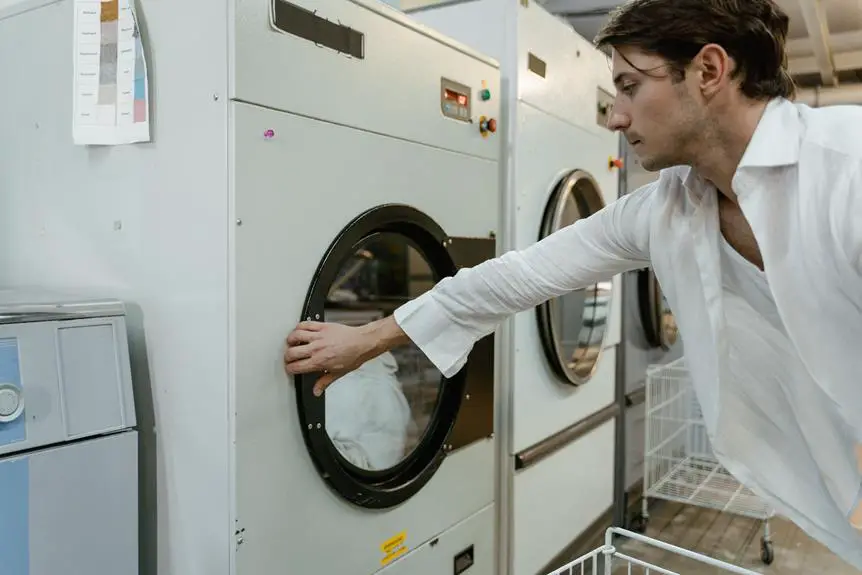A dryer not heating properly can be due to several reasons.
- Lint buildup in the trap or vent can block airflow, decreasing heating efficiency. The vent hose should be checked for blockages or damage that may prevent hot air from escaping.
- If the heating element, thermostats, or fuses are faulty, they can affect temperature regulation.
- Overloading the dryer or issues from the washing process, like clothes being too wet, can also cause poor drying.
It's important to identify and fix these problems to ensure the dryer works correctly and to avoid safety risks.
Inspecting the Lint Trap
Check and clean the lint trap regularly to ensure proper airflow in the dryer.
A blocked lint screen can reduce drying efficiency and may prevent the heating element or gas burner from reaching the required temperature, resulting in damp clothes after a cycle.
Additionally, a clogged vent can pose a fire risk and cause excessive wear on the dryer.
Clean the lint trap and ductwork to maintain safety and performance.
Regular maintenance is essential for optimal operation.
Evaluating Vent Hose Condition
After checking the lint trap, it's important to examine the vent hose. This hose allows hot air to leave the dryer, and if it's blocked or damaged, it can cause the dryer to work inefficiently or increase drying times.
Look for any twists, blockages, or crushing in the vent hose, as these can severely limit airflow. Such obstructions not only affect drying but also present a fire risk due to lint build-up. If the hose is in poor condition or bent sharply, it should be replaced to improve dryer performance.
The vent hose must be correctly installed, with a diameter that matches your dryer model and a path to the outside exhaust that is as short and straight as possible. Long hoses with many bends can restrict airflow and cause moisture to remain in the clothes.
Regular cleaning of the vent is essential. Lint can collect in the lint trap, the vent hose, and the exhaust's exit. If you're not confident in cleaning the vent or it hasn't been done in a while, you should hire a professional vent cleaning service.
Maintaining a clear vent hose is crucial for safe and efficient dryer operation.
Checking Exhaust Vent Flow
Regularly check the dryer's exhaust vent to maintain performance. If clothes are damp after drying, a blocked vent may be to blame, hindering heat and moisture removal.
Before inspecting the vent, disconnect the dryer from power for safety. Inspect the vent for blockages or damage. Perform an airflow test by running the dryer with the vent hose removed; air should flow strongly. Weak or no airflow suggests a duct obstruction.
Check that external vent flaps open during dryer operation. Lint accumulation at the vent exit indicates a blockage. Remove lint and clear the vent path to ensure safe and efficient operation.
For vents longer than 42 feet or with multiple turns, professional cleaning may be necessary to prevent fire risks and maintain drying efficiency. Regular maintenance is crucial for safety and performance.
Troubleshooting the Heating Element
When troubleshooting a dryer that isn't heating properly, it's essential to check the heating element for wear or damage, as it's responsible for heating the air in the dryer. Before starting, make sure the dryer is unplugged and disconnected from the electrical supply for safety.
To inspect the heating element, remove the dryer's back panel. Look for breaks or blisters on the coil; these are signs that the element needs replacement. Use a multimeter to test for continuity; if the reading shows an open circuit or if there's visible damage, the element is faulty and must be replaced.
Also, examine the cycling thermostat, which controls the temperature by turning the heat on and off. Test it for continuity with a multimeter. If there's no continuity at room temperature, replace the thermostat.
Ensure the vent hose is not blocked and that the lint screen and exhaust vent are clean to maintain proper airflow. If the vent system is clear and other components are working, replacing the heating element should solve the heating problem.
Assessing Thermostats and Fuses
Checking the thermostats and fuses is essential when troubleshooting a dryer that doesn't heat properly. Thermostats regulate temperature, and fuses prevent overheating.
Use a multimeter to test the thermostats and fuses for continuity. The thermal fuse, a one-time safety device, cuts power to the heating element if the dryer gets too hot. If it has tripped, you need to replace it, as it cannot be reset. A blown thermal fuse may be why clothes remain damp after a cycle.
The cycling thermostat controls the heat cycle to keep the dryer at the right temperature. If it's faulty, it might turn off the heat prematurely or not activate it. The safety thermostat also turns off heat to avoid overheating.
If you're not comfortable checking these components yourself, consider hiring a professional. A technician can diagnose and repair the dryer efficiently, ensuring it meets safety standards and works correctly.





